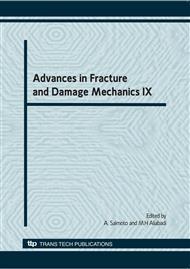p.809
p.813
p.817
p.821
p.825
p.829
p.833
p.837
p.841
Modelling of Cyclic Plasticity and Crack Propagation
Abstract:
An experimental and numerical study of the cyclic deformation and low-cycle fatigue behaviour of the aluminium alloy AlCu5BiPb–T8 is presented. The experimental program included monotonic tensile tests, symmetric and unsymmetric strain-controlled fatigue tests, fracture toughness tests, as well as fatigue crack initiation and propagation tests. Within the framework of numerical investigations an efficient algorithm for modelling of cyclic plasticity is proposed. This algorithm is implemented into the finite element program ABAQUS and applied to the analysis of a crack growth near the notch. The accuracy of the computational procedure is tested by comparing the computed results with the real experimental data.
Info:
Periodical:
Pages:
825-828
Citation:
Online since:
November 2010
Authors:
Keywords:
Price:
Сopyright:
© 2011 Trans Tech Publications Ltd. All Rights Reserved
Share:
Citation:


